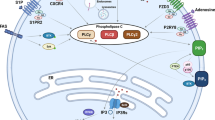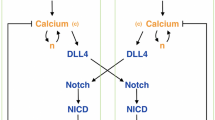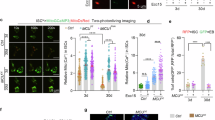Abstract
Cells undergo programmed cell death/apoptosis throughout the lifespan of an organism. The subsequent immunologically silent removal of apoptotic cells plays a role in the maintenance of tolerance; defects in corpse clearance have been associated with autoimmune disease. A number of receptors and signaling molecules involved in this process have been identified, but intracellular signaling downstream of corpse recognition is only now being defined. Calcium plays a key role as a second messenger in many cell types, leading to the activation of downstream molecules and eventual transcription of effector genes; however, the role of calcium signaling during apoptotic cell removal is unclear. Here, using studies in cell lines and in the context of a whole organism, we show that apoptotic cell recognition induces both an acute and sustained calcium flux within phagocytes and that the genes required for calcium flux are essential for engulfment. Furthermore, we provide evidence that both the release of calcium from the endoplasmic reticulum and the entry of extracellular calcium through CRAC channels into the phagocytes are important during engulfment. Moreover, knockdown in Caenorhabditis elegans of stim-1 and jph-1, two genes linked to the entry of extracellular calcium into cells, led to increased persistence of apoptotic cells in the nematode. Loss of these genes seemed to affect early signaling events, leading to a decreased enrichment of actin adjacent to the apoptotic cell during corpse removal. We also show that calcium is crucial for the secretion of TGF-β by the phagocytes during the engulfment of apoptotic cells. Taken together, these data point to an earlier unappreciated and evolutionarily conserved role for calcium flux at two distinguishable steps: the formation of the phagocytic cup and the internalization of the apoptotic cell, and the anti-inflammatory signaling induced in phagocytes by contact with apoptotic cells.
Similar content being viewed by others
Log in or create a free account to read this content
Gain free access to this article, as well as selected content from this journal and more on nature.com
or
Abbreviations
- TGF-β:
-
transforming growth factor-β
- CRAC channels:
-
calcium release-activated calcium channels
- STIM:
-
stromal interaction molecule
- Ca2+:
-
calcium ion
- TNF-α:
-
tumor necrosis factor-α
- LPS:
-
lipopolysaccharide
- ER:
-
endoplasmic reticulum
- BAPTA:
-
1,2-bis(o-aminophenoxy)ethane-N,N,N′,N′-tetraacetic acid
- EGTA:
-
ethylyne glycol tetraacetic acid
- Mg2+:
-
magnesium ion
- SERCA:
-
sarco/endoplasmic reticulum Ca2+-ATPase
- TAMRA:
-
carboxytetramethylrhodamine
- DMSO:
-
dimethyl sulfoxide
- ORAI:
-
ORAI calcium release-activated calcium modulator
- siRNA:
-
small interfering RNA
- JPH:
-
junctophilin
References
Erwig LP, Henson PM . Immunological consequences of apoptotic cell phagocytosis. Am J Pathol 2007; 171: 2–8.
Monks J, Smith-Steinhart C, Kruk ER, Fadok VA, Henson PM . Epithelial cells remove apoptotic epithelial cells during post-lactation involution of the mouse mammary gland. Biol Reprod 2008; 78: 586–594.
Savill J, Dransfield I, Gregory C, Haslett C . A blast from the past: clearance of apoptotic cells regulates immune responses. Nat Rev Immunol 2002; 2: 965–975.
Erwig LP, Henson PM . Clearance of apoptotic cells by phagocytes. Cell Death Differ 2008; 15: 243–250.
Cvetanovic M, Ucker DS . Innate immune discrimination of apoptotic cells: repression of proinflammatory macrophage transcription is coupled directly to specific recognition. J Immunol 2004; 172: 880–889.
Lewis RS . Calcium signaling mechanisms in T lymphocytes. Annu Rev Immunol 2001; 19: 497–521.
Watanabe N, Suzuki J, Kobayashi Y . Role of calcium in tumor necrosis factor-alpha production by activated macrophages. J Biochem 1996; 120: 1190–1195.
Cuttell L, Vaughan A, Silva E, Escaron CJ, Lavine M, Van Goethem E et al. Undertaker, a Drosophila Junctophilin, links Draper-mediated phagocytosis and calcium homeostasis. Cell 2008; 135: 524–534.
Oh-Hora M, Rao A . Calcium signaling in lymphocytes. Curr Opin Immunol 2008; 20: 250–258.
Feske S . Calcium signalling in lymphocyte activation and disease. Nat Rev Immunol 2007; 7: 690–702.
Hynes RO . Integrins: bidirectional, allosteric signaling machines. Cell 2002; 110: 673–687.
Dransfield I, Cabanas C, Craig A, Hogg N . Divalent cation regulation of the function of the leukocyte integrin LFA-1. J Cell Biol 1992; 116: 219–226.
Tosello-Trampont AC, Brugnera E, Ravichandran KS . Evidence for a conserved role for CRKII and Rac in engulfment of apoptotic cells. J Biol Chem 2001; 276: 13797–13802.
Hajnoczky G, Csordas G, Das S, Garcia-Perez C, Saotome M, Sinha RS et al. Mitochondrial calcium signalling and cell death: approaches for assessing the role of mitochondrial Ca2+ uptake in apoptosis. Cell Calcium 2006; 40: 553–560.
Kang HW, Park JY, Jeong SW, Kim JA, Moon HJ, Perez-Reyes E et al. A molecular determinant of nickel inhibition in Cav3.2 T-type calcium channels. J Biol Chem 2006; 281: 4823–4830.
Kimura J, Miyamae S, Noma A . Identification of sodium-calcium exchange current in single ventricular cells of guinea-pig. J Physiol 1987; 384: 199–222.
Yoshino T, Ishikawa J, Ohga K, Morokata T, Takezawa R, Morio H et al. YM-58483, a selective CRAC channel inhibitor, prevents antigen-induced airway eosinophilia and late phase asthmatic responses via Th2 cytokine inhibition in animal models. Eur J Pharmacol 2007; 560: 225–233.
Zitt C, Strauss B, Schwarz EC, Spaeth N, Rast G, Hatzelmann A et al. Potent inhibition of Ca2+ release-activated Ca2+ channels and T-lymphocyte activation by the pyrazole derivative BTP2. J Biol Chem 2004; 279: 12427–12437.
Penna A, Demuro A, Yeromin AV, Zhang SL, Safrina O, Parker I et al. The CRAC channel consists of a tetramer formed by Stim-induced dimerization of Orai dimers. Nature 2008; 456: 116–120.
Kinchen JM, Doukoumetzidis K, Almendinger J, Stergiou L, Tosello-Trampont A, Sifri CD et al. A pathway for phagosome maturation during engulfment of apoptotic cells. Nat Cell Biol 2008; 10: 556–566.
Roos J, DiGregorio PJ, Yeromin AV, Ohlsen K, Lioudyno M, Zhang S et al. STIM1, an essential and conserved component of store-operated Ca2+ channel function. J Cell Biol 2005; 169: 435–445.
Liou J, Kim ML, Heo WD, Jones JT, Myers JW, Ferrell Jr JE et al. STIM is a Ca2+ sensor essential for Ca2+-store-depletion-triggered Ca2+ influx. Curr Biol 2005; 15: 1235–1241.
Kinchen JM, Cabello J, Klingele D, Wong K, Feichtinger R, Schnabel H et al. Two pathways converge at CED-10 to mediate actin rearrangement and corpse removal in C. elegans. Nature 2005; 434: 93–99.
Takeshima H, Komazaki S, Nishi M, Iino M, Kangawa K . Junctophilins: a novel family of junctional membrane complex proteins. Mol Cell 2000; 6: 11–22.
Fadok VA, Bratton DL, Konowal A, Freed PW, Westcott JY, Henson PM . Macrophages that have ingested apoptotic cells in vitro inhibit proinflammatory cytokine production through autocrine/paracrine mechanisms involving TGF-beta, PGE2, and PAF. J Clin Invest 1998; 101: 890–898.
Kim S, Elkon KB, Ma X . Transcriptional suppression of interleukin-12 gene expression following phagocytosis of apoptotic cells. Immunity 2004; 21: 643–653.
Casella JF, Flanagan MD, Lin S . Cytochalasin D inhibits actin polymerization and induces depolymerization of actin filaments formed during platelet shape change. Nature 1981; 293: 302–305.
Park D, Hochreiter-Hufford A, Ravichandran KS . The phosphatidylserine receptor TIM-4 does not mediate direct signaling. Curr Biol 2009; 19: 346–351.
Park D, Tosello-Trampont AC, Elliott MR, Lu M, Haney LB, Ma Z et al. BAI1 is an engulfment receptor for apoptotic cells upstream of the ELMO/Dock180/Rac module. Nature 2007; 450: 430–434.
Miyanishi M, Tada K, Koike M, Uchiyama Y, Kitamura T, Nagata S . Identification of Tim4 as a phosphatidylserine receptor. Nature 2007; 450: 435–439.
Park SY, Jung MY, Kim HJ, Lee SJ, Kim SY, Lee BH et al. Rapid cell corpse clearance by stabilin-2, a membrane phosphatidylserine receptor. Cell Death Differ 2008; 15: 192–201.
Gardai SJ, Bratton DL, Ogden CA, Henson PM . Recognition ligands on apoptotic cells: a perspective. J Leukoc Biol 2006; 79: 896–903.
Oh-Hora M, Yamashita M, Hogan PG, Sharma S, Lamperti E, Chung W et al. Dual functions for the endoplasmic reticulum calcium sensors STIM1 and STIM2 in T cell activation and tolerance. Nat Immunol 2008; 9: 432–443.
Rogers TB, Inesi G, Wade R, Lederer WJ . Use of thapsigargin to study Ca2+ homeostasis in cardiac cells. Biosci Rep 1995; 15: 341–349.
Kijima Y, Ogunbunmi E, Fleischer S . Drug action of thapsigargin on the Ca2+ pump protein of sarcoplasmic reticulum. J Biol Chem 1991; 266: 22912–22918.
Lytton J, Westlin M, Hanley MR . Thapsigargin inhibits the sarcoplasmic or endoplasmic reticulum Ca-ATPase family of calcium pumps. J Biol Chem 1991; 266: 17067–17071.
Toyoshima C, Nomura H . Structural changes in the calcium pump accompanying the dissociation of calcium. Nature 2002; 418: 605–611.
Brugnera E, Haney L, Grimsley C, Lu M, Walk SF, Tosello-Trampont AC et al. Unconventional Rac-GEF activity is mediated through the Dock180-ELMO complex. Nat Cell Biol 2002; 4: 574–582.
Tosello-Trampont AC, Kinchen JM, Brugnera E, Haney LB, Hengartner MO, Ravichandran KS . Identification of two signaling submodules within the CrkII/ELMO/Dock180 pathway regulating engulfment of apoptotic cells. Cell Death Differ 2007; 14: 963–972.
Kamath RS, Fraser AG, Dong Y, Poulin G, Durbin R, Gotta M et al. Systematic functional analysis of the Caenorhabditis elegans genome using RNAi. Nature 2003; 421: 231–237.
Grimsley CM, Lu M, Haney LB, Kinchen JM, Ravichandran KS . Characterization of a novel interaction between ELMO1 and ERM proteins. J Biol Chem 2006; 281: 5928–5937.
Acknowledgements
We thank the members of the Ravichandran and Franc labs and Dr. D Haverstick for helpful discussions. We gratefully acknowledge the help of Marcin Iwanicki with the calcium experiments. This work was supported by grants from the National Institutes of Health (NIGMS) and American Asthma Foundation to KSR, and by post-doctoral fellowships from the Natural Sciences and Engineering Research Council of Canada (NSERC) to MAG and the Arthritis Foundation to JMK, as well as Immunology Training Grants from the NIAID (National Institutes of Health, USA) to IJJ and JMK.
Author information
Authors and Affiliations
Corresponding author
Additional information
Edited by S Nagata
Conflict of interest
The authors declare no conflict of interest.
Supplementary Information accompanies the paper on Cell Death and Differentiation website (http://www.nature.com/cdd)
Supplementary information
Rights and permissions
About this article
Cite this article
Gronski, M., Kinchen, J., Juncadella, I. et al. An essential role for calcium flux in phagocytes for apoptotic cell engulfment and the anti-inflammatory response. Cell Death Differ 16, 1323–1331 (2009). https://doi.org/10.1038/cdd.2009.55
Received:
Revised:
Accepted:
Published:
Issue date:
DOI: https://doi.org/10.1038/cdd.2009.55
Keywords
This article is cited by
-
PFKFB2-mediated glycolysis promotes lactate-driven continual efferocytosis by macrophages
Nature Metabolism (2023)
-
Internalization of apoptotic cells during efferocytosis requires Mertk-mediated calcium influx
Cell Death & Disease (2023)
-
Efferocytosis requires periphagosomal Ca2+-signaling and TRPM7-mediated electrical activity
Nature Communications (2022)
-
Crbn modulates calcium influx by regulating Orai1 during efferocytosis
Nature Communications (2020)
-
Sodium channels enable fast electrical signaling and regulate phagocytosis in the retinal pigment epithelium
BMC Biology (2019)



